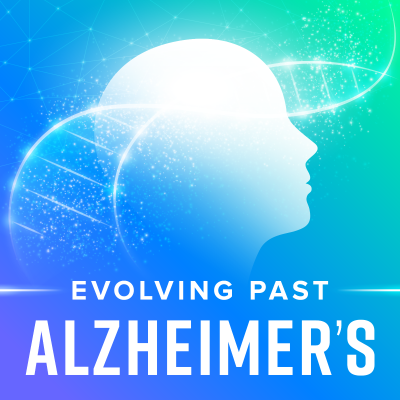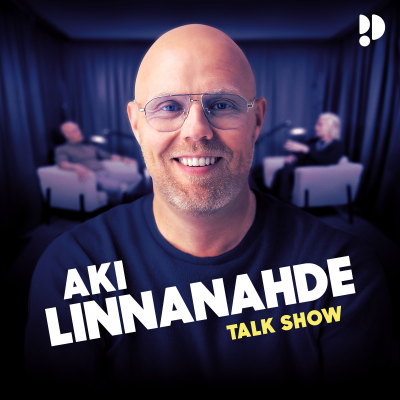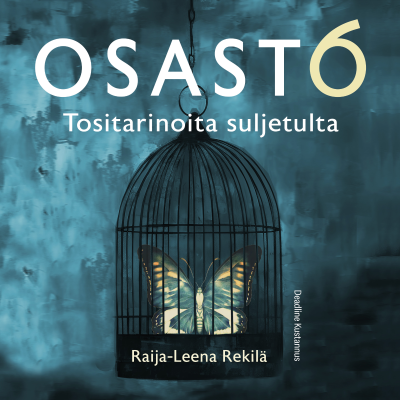
Evolving Past Alzheimer's
Podcast by Evolving Past Alzheimer's
We are absolutely convinced that Alzheimer’s and other brain diseases are generally treatable and reversible. Early translational evidence supports this belief. The Evolving Past Alzheimer’s podcast brings you the highest caliber information about what you can do to identify, prevent, and treat Alzheimer’s disease. The show’s secondary goal is to use Alzheimer’s and cognition as a platform to explore consciousness and the human experience in it’s “second half of life.” Topics include emerging technologies, transhumanism, traditional medicinal approaches, spiritual conversations, and stories of people living with – and through – Alzheimer’s. This show brings you conversations with experts around the world that are leading the charge in treatment and prevention of Alzheimer’s and other brain disease.
Aloita 7 vrk maksuton tilaus
Kokeilun jälkeen 7,99 € / kuukausi.Peru milloin tahansa.
Kaikki jaksot
77 jaksotWhat if what we thought to be the primary cause ofAlzheimer'swas not true? Dr. NateBergman delves into a research article published by Dr. Weaver to assess if the primary cause of Alzheimer's can be limited to only the amyloid area. For years it has been believed that the main causes of Alzheimer’s disease are the abnormal build-up of proteins in and around the brain cells. The main toxic protein involved in this is called the amyloid beta which accumulates and builds up like plaque around the brain cells. However, in recent times, the hypothesis that originated in 2006 and was believed by many was brought into question leading to research being done on the alternative hypotheses and waiting on funding to expand the area of study accessible. The role of amyloid beta has been kept in focus when planning and prescribing Alzheimer's disease treatment to patients suffering from it. However, it is essential to understand that one person's Alzheimer's is not the same as another’s. Thus, one treatment cannot be the answer for everyone. Such observation requires that this matter is dissected further to evaluate what is the core cause of the disease, how it varies, and what Alzheimer’s treatment can prove to be effective against the disease. For more information about your assessment options for cognitive issues or Alzheimer's, contact Kemper Cognitive Wellness in Cleveland, Ohio. Email: info@kemperwellness.com [info@kemperwellness.com] Website: https://kemperwellness.com/ [https://kemperwellness.com/] Phone: (216) 337-1400.
In This Episode You Will Learn: Where are you in your career right now? Neuroscience research is fascinating. Dr. Ted is most interested in attention, perception, and memory. These three things work together harmoniously because you can’t remember something you ignore, and it’s difficult to notice something if you don’t perceive it in the beginning. Dr. Ted studied how the brain encodes beats. He uses music perception to enable people to pay attention, listen, and remember information. He worked with Adam Gaza and researched aging's attention, memory, and perception. Their research indicated that some memory issues stem from attentional issues, inhibiting irrelevant information. How does this process change as we grow? It’s not a problem with memory capacity; it’s more on the intentional filtering issue. When you add distraction (in a lab setting), adults will show deficient memory performance compared to young adults when you test them on the content they were told to remember. But if you test them on the content they were supposed to ignore, older adults remember the better. The research now is more on assessing the different potential therapeutics to help people focus their attention and improve their memory performance. There are two ways: musical training to facilitate attention to memory performance and noninvasive neurostimulation using a magnetic field of electrical currents to retrain neuro oscillation that underlies attention to memory processes and rescues the brain’s cognitive abilities to mediate age-related problems. What aspects of perception do you focus on? Dr. Theodore focuses on perceiving or experiencing things such as the sound of one’s voice or picture. Dr ted is focused chiefly on vision and audition. That’s humans’ ability to see and ability to hear. The brain has a region dedicated to visual processing and another region for auditory processing. These regions are highly connected. The brain can ramp out or tune out noises. Like a radio equalizer, the brain controls the volume to either ramp up a particular sound to hear more or tune out from other background noise. You can focus on one person’s voice even in a noisy crowd. Why is brain oscillation significant? Brain oscillation means the frequencies at which the brain and neurons are firing. They become active at different frequencies. When you sleep, you get these slow bursts of activities. We call these delta waves. The neurons can burst in a range of thousand hertz. The brain oscillates at lower frequencies, but the other neurons pick up the slack. If you record a large group of neurons, you will get high frequencies. Dr. Ted uses EEG or fMRI to look at large swabs of the cortex. It includes hundreds of thousands of neurons in one group. When you get that number of neurons synchronously firing together, you get temporal resolution and can detect oscillations. While you can’t get the resolution you need for an individual neuron, you can get a lot of exciting information from 70 Herts and below. What would the program look like? The research is mainly on assessing how attention, memory, and perception. We are looking at the interaction of these things across the lifespan, how it degrades potentially as people get older, and how we might be able to remediate that. In studying the brain, they’ve identified specific mechanisms for specific interventions. The frontal theta activity seems to be involved in the complex cognitive function of one’s multitasking ability. For example, one study looked at how people multitask. Research shows that people peak at multitasking in their twenties, which declines as they age. The process was a little car simulation where respondents had to drive a car and respond to street signs. The goal was to assess how w brain can multitask by driving a car and responding to streetlights simultaneously. Younger adults were better at it, but a month into playing the simulation paradigm, older people were able to improve their multitasking abilities. It shows that frontal data is related to one’s ability to focus your attention and remember objects. Another study was done to shorten the brain’s improvement to multitask. They had young adults at their peak, stimulating their brains at six Herts. It’s what they call theta stimulation. Results showed that after an hour, this group improved this multitasking ability as opposed to those who could feel the stimulation but didn’t get the total dose. This method was then replicated in older adults. The session ran over an hour initially. But for the older adults, the protocol was done in three days. The Variables There are a lot of individual variabilities here since not everyone responds the same to the treatment. Even then, we can now estimate the conductivity and resistivity of the skin, the scalp, the cerebral spinal fluid, the gray matter, and the white matter in the brain. But, to do that, we needed to have an actual picture of each brain. Dr. Ted and his team brought the respondents for an MRI to take a high-resolution picture of their heads, including the scalp, the brain, and the CSF. The results allowed them to assign resistance to all the tissue types. Eventually, they were able to get into each person’s brain. It’s helpful to know that the efficacy of stimulation can be affected by one’s anatomy. As a person ages, the brain degenerates and shrinks a bit. The more it does, the less current is likely to go into the brain. When dealing with an aging population or people with neurodegenerative disorders, that's important. When dealing with an aging population or people with neurodegenerative disorders, that's important. People with more atrophy will likely need a higher dose of stimulation for the current to reach the brain. This result helps us understand the individual differences of people. Other brains work faster, so they need fewer pulses per second for the current to reach the brain. It means people won’t function as efficiently when stimulated at the inaccurate Hertz level. This means that brains need to oscillate at a frequency that matches. What does this mean for people with neurogenerative disorders such as Alzheimer's? Intensity is an important question here. They tried different intensities, showing that the higher the intensity, the more effective it is. However, they still saw some improvements in memory, even with lower intensities. Lowered beta-load is one of the biomarkers associated with Alzheimer’s. With the stimulation, we saw an increase in microglia. These neurons help clear the amyloid plaques. TACS is a more practical solution than other types of neurostimulation requiring complicated electronics. If this demonstrates the efficacy, it can be used with other treatments for Alzheimer's. The study is still in the research phase, but still, this is a practical solution. What’s great about this neurostimulation is that if you stimulate a node of network regions that are functionally connected, you can manipulate brain activities. Even if the stimulation doesn’t reach the hippocampus, if they’re able to hit a region of the cortex that communicates with the hippocampus, then it’s believed that it can impact the hippocampus and fire out activities in the rain. TACS Stimulation It’s hard to hit a specific quadrant in the brain and stimulate it. It takes some time before the stimulation can start seeing real effects. Right now, it’s still in its early stages. So, it’s just about seeing what works, understanding the why, and looking for answers. Everything comes at a cost. There are activities that people do that affect how the brain functions and be stimulated. The same is accurate with the hertz and other frequencies. The stimulation and work may impact the brain at a specific frequency. People could be doing other things to improve multiple functions, but at the moment, science is doing this, and hopefully, it bears good results. About the Guest: Dr. Theodore Zanto Director of Neurology at Neuroscape and Assoc Prof at UCSF. He specializes in brain imaging and non-invasive studies on the brain, especially on attention, perception, and memory studies. For more information about your assessment options for cognitive issues or Alzheimer's, contact Kemper Cognitive Wellness in Cleveland, Ohio. Email: info@kemperwellness.com [info@kemperwellness.com] Website: https://kemperwellness.com/ [https://kemperwellness.com/] Phone: (216) 337-1400.
6 Effective Ways of Heart Disease Prevention Anyone who wishes to optimize health by protecting the heart and brain must listen to this! Dr. Marwan Sabbagh and Joe Piscatella combine the six most effective principles for heart disease prevention. They unfold valuable heart and brain facts in their new book Strong Heart, Sharp Mind, which are equally beneficial for the prevention of Alzheimer's disease. In a way, they open hope for effective heart disease treatments, dealing with Alzheimer's, and other brain ailments with a multidisciplinary approach. What is good for your heart is good for your brain and ultimately contributes to your overall healthy lifestyle. This episode guides listeners to optimal well-being using a 6-Step Brain-Body Balance Program. In this discussion, he adds that the mechanism that underpins heart disease symptoms considerably overlaps with the symptoms of Alzheimer's. Therefore, aggressively managing the cures for one has two or more benefits. How Is Heart Disease The # 1 Cause Of Death Worldwide? Researchers agreed that cardiovascular arrest, high blood pressure, and cholesterol are risk factors for many other diseases like Alzheimer's. High blood pressure is one of the mechanisms overlapping Alzheimer's and heart disease symptoms, making it the most deadly disease of all time. Dr. Sabbagh believes aggressively managing cholesterol and high blood pressure might considerably help heart disease prevention through natural anti-inflammatory processes. He adds that saturated fats are bad for the brain, which triggers amyloid (an unhealthy protein in the brain), hindering ongoing heart disease treatment. Is High Blood Pressure A Contributor to Heart Disease? National Academy of Sciences, Engineering, and Medicines analyzed the whole shebang, including diet, cognitive stimulation, exercise, health conditions, etc. They came up with their thorough and expert analysis that blood pressure management, mental stimulation, and exercise were the only three things that showed sufficient evidence to recommend them in clinical practices. Several other health organizations are researching, concluding that high blood pressure management is the ultimate risk reduction strategy for the heart and brain. What Are Neurobics? Neurobics are brain exercises that aid in healthy mental activities and prevent severe diseases such as Alzheimer's and heart disease. Dr. Sabbagh suggests Neurobics as a way of simultaneously doing physical activity and cognitive stimulation. In the book, the author outlines the perfect Neurobics that can improve heart function and blood vessel health. Transforming The American Diet into A Healthful Way to Eat According to Berkeley Wellness Letter, Nutrition Actions, and Tufts Newsletter, modest dietary changes can help fight heart disease symptoms. Similarly, one fish meal a week, two berries a week, and two vegetables a day can reduce Alzheimer's disease risk. Managing Alzheimer's with A Good Sleep Regimen Sleep apnea is a huge risk for heart attacks as well as a considerable risk for cognitive decline. Quality sleep is the procedure by which your brain removes the amyloids. That's why Dr. Sabbagh refers to sleep as an easy fix to our mild cognitive illness. Exercise during the daytime, regular meal times, waking up, and going to bed are far more beneficial than sleeping pills. Also, there is a link between inadequate sleep quality, plaque building, and high blood pressure. How Stress Management Is Vital To Defeat Heart Diseases A person's mental health can positively or negatively impact their physical health, and the risk of heart failure may increase with high blood pressure. So, they refer to a phenomenon called 'hippie genetics,' which has secondary benefits in dealing with stress and reducing risks for heart disease. As said, you are more likely to be stress-free if you are physically active and socially connected, leading a healthy lifestyle. Keep your heart pumping and passions alive by knowing what is good for you. If you have people that support you and share the same bond, you are more likely to be mentally healthy. The people who practice cognitive stimulation are the people who exercise and eat right and ultimately lead a healthy lifestyle. However, it is more important to practice mental stimulation even if you have heart disease symptoms or Alzheimer's. The book gives you a great plan to follow that. About the Guest: Marwan Noel Sabbagh, M.D, formerly the Director of the Lou Ruvo Center for Brain Health at Cleveland Clinic, is internationally known for his expertise in the brain and vascular disorders like Alzheimer's and related dementias. For more information about your assessment options for cognitive issues or Alzheimer's, contact Kemper Cognitive Wellness in Cleveland, Ohio. Email: info@kemperwellness.com [info@kemperwellness.com] Website: https://kemperwellness.com/ [https://kemperwellness.com/] Phone: (216) 337-1400.
The conversation had on this episode is a little complex but is an excellent review in how science is done and "how the sausage is made" in terms of medical evidence in peer review for Alzheimer's treatments. We discuss the results of the AMBAR trial [https://alz-journals.onlinelibrary.wiley.com/doi/full/10.1002/alz.12137] - The Alzheimer Management by Albumin Replacement - where people with mild to moderate Alzheimer's showed significant improvements after having their blood plasma exchanged in addition to receiving either IV Albumin as well as IVIg (in some of the experimental groups). The study doesn't offer an explanation of the mechanisms around why Albumin and IVIg might have been effective, but a robust conversation about the research and the durability of the positive results ensues. Our guest is an international leader in Alzheimer's, Mercé Boada Rovira MD, PhD founder and director of the ACE Alzheimer's Center in Barcelona, Spain. Dr Boada has led and published results of over 100 Alzheimer's prevention and treatment trials over the many decades of her career. This episode was co-produced and co-hosted by, Brett Graham, MD. Brett is a 2nd year neurology resident at Vanderbilt University Medical Center. What is plasma exchange? Also called plasmapheresis or PLEX. A procedure in which a machine is used to separate the liquid part of blood from the blood cells and then filtered similar to dialysis except that in plasma exchange big things like protein and antibodies are removed whereas in dialysis smaller molecules and electrolytes are the target. Because proteins are removed from blood in the process they are usually replaced with something like albumin afterwards. This treatment is mostly commonly used in treating certain autoimmune diseases like myasthenia gravis, Guillan Barre Syndrome, and thrombotic thrombocytopenic purpura (TTP) but it is also used in diseases where too much of a particular substance builds up in the blood such as in multiple myeloma or familial hypercholesterolemia. What is albumin? Albumin is the main protein component of blood that serves to balance concentration gradients between the blood and tissues as well as shuttle many other molecules through the bloodstream. This is removed during plasma exchange and so must be at least partially replaced after a session. What is IVIG? IVIG stands for intravenous immunoglobulin and is basically pooled antibodies from blood donors, which when administered to a patient have a variety of effects, many of which are still not fully understood, but you can basically think about these antibodies non-specifically binding to and neutralizing autoantibodies and other bad stuff in the blood. Again, this is most commonly used to treat autoimmune diseases. For consultation or evaluation by Dr Nate Bergman call, 216-337-1400 or visit our website www.Kemperwellness.com [http://www.Kemperwellness.com]
In July 2021, the journal Frontiers in Neurology reported on "groundbreaking research" out of Tulane pointing to the relationship between Lyme disease and Alzheimer’s dementia. But since the 1980s our guest on this episode, Dr. Alan MacDonald, was stirring up the scientific debate by publishing and presenting data from his pathology laboratory that the bacteria - Borrelia Burgdorferi often synonymous with what's called Lyme disease, because of its association with its US origins in the town of Lyme, Connecticut. Dr. MacDonald graduated with an MD from Columbia University. He has completed 35 years of research in Borrelia and Lyme disease and has published numerous peer-reviewed articles on the pathology of Lyme and its role in Alzheimer's, dementia, and other diseases. This show is dedicated to my mother, Susan Bergman MD, the #1 fan and supporter of the show - who was the first and coolest pathologist I’ve ever known. For more information on how you can prevent or push back against Alzheimer's and other dementias visit Kemperwellness.com [http://Kemperwellness.com] or call (216) 337-1400. We have support programs, virtual classes, and many other options. Consider supporting the Evolving Past Alzheimer's podcast at patreon.com/evolvingpast [http://patreon.com/evolvingpast] so we can continue to bring you the information most helpful to you. 3:00 - What is a pathologist? 9:35 - Why Alan believes some of Alzheimer's cases have microbial origins 15:07 - Why has it taken so long to recognize chronic Lyme disease? 24:34 - What percentage of Alzheimer's patients have microbes like Lyme in their body? 28:42 - How to get a diagnosis with Lyme 42:12 - The possibilities for the treatment of Lyme disease
Aloita 7 vrk maksuton tilaus
Kokeilun jälkeen 7,99 € / kuukausi.Peru milloin tahansa.
Podimon podcastit
Mainoksista vapaa
Maksuttomat podcastit



















